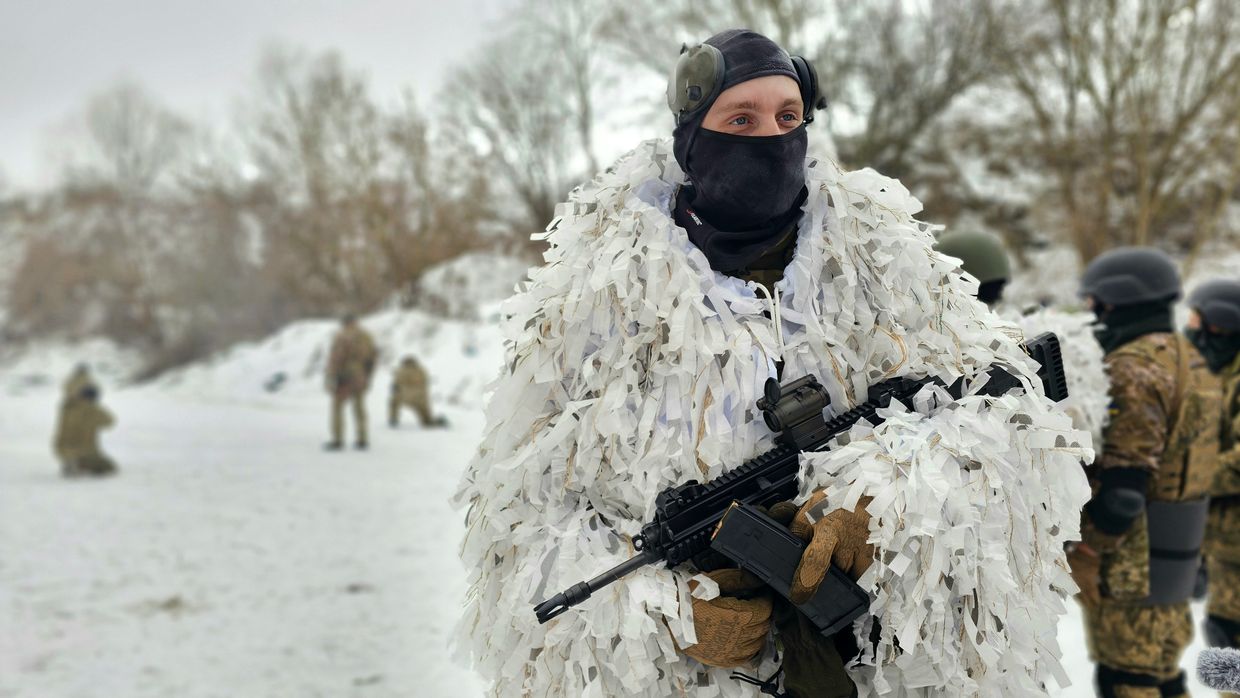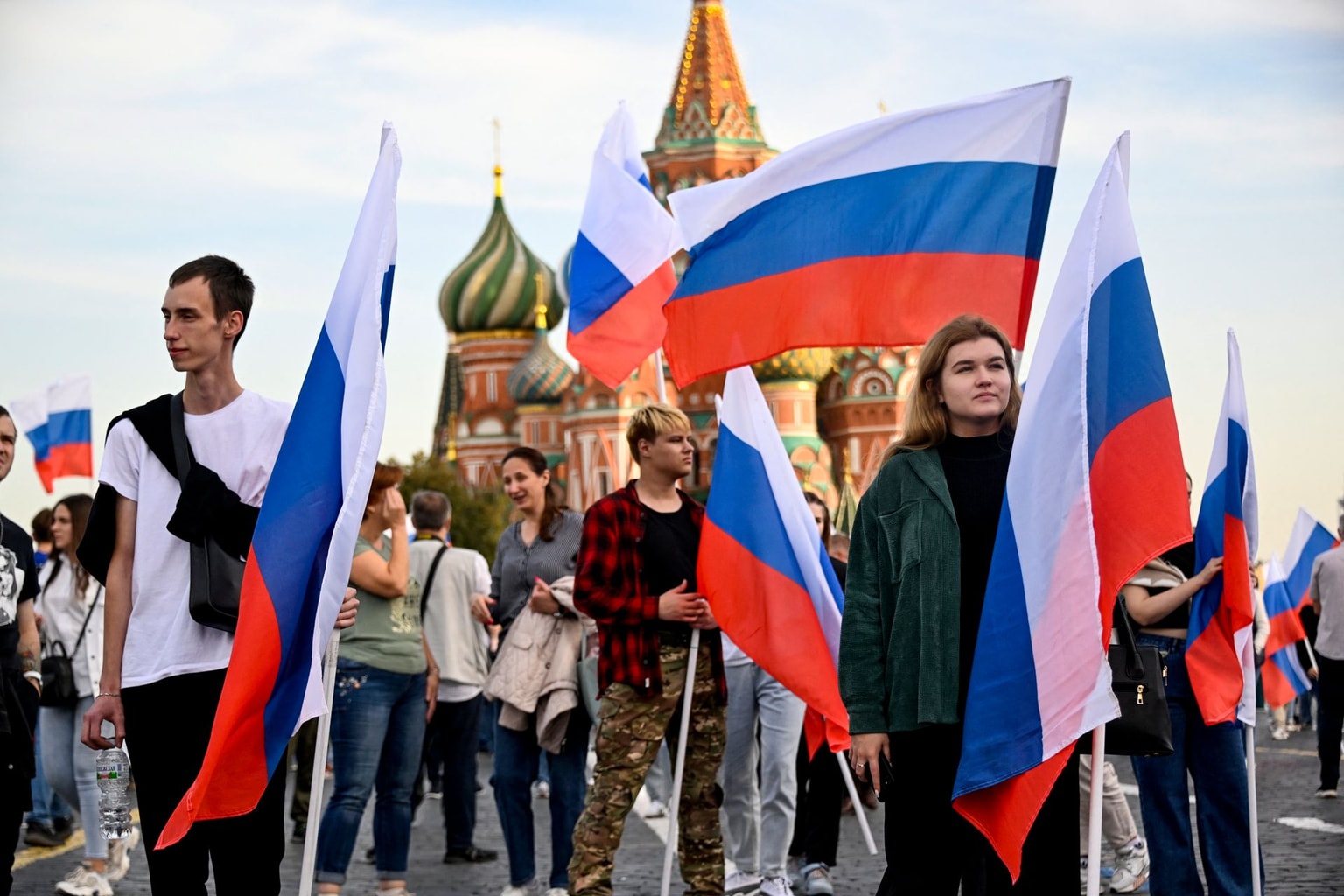
Evidence shows recent presidential elections most rigged in Russia’s modern history
Preliminary results of the presidential election are displayed on a screen at the campaign headquarters of Russian President and presidential candidate Vladimir Putin in Moscow on March 17, 2024. (Natalia Kolesnikova / AFP via Getty Images)
The March 15-17 presidential election was the most rigged in Russia's modern history, according to evidence published by election experts, observers, and media.
Estimates of vote rigging range from at least 22 million votes to about 31.6 million votes, without taking into account the online voting and the election at gunpoint in Russian-occupied parts of Ukraine.
If these results are included, voting fraud could have amounted to up to around 40 million votes, or 46% of the people who allegedly voted.
The evidence for voting fraud included video footage from polling stations and a mathematical analysis of election data.
Apart from voting fraud, intimidation, the forced voting of state sector employees, massive state propaganda, and the exclusion of stronger competitors from the presidential race were used to ensure the desired result.
"This is the Chechenization of the electoral process," Russian political analyst Dmitry Oreshkin told the Kyiv Independent, implying that election results all over Russia now resemble those in Chechnya, which is famous for its blatant voting fraud.
"There has never been such an amount of vote rigging before."
Mathematical analysis, video footage
Russian election expert Sergei Shpilkin has devised a method to estimate the amount of vote rigging in Russian elections.
In normal, or Gaussian, distribution in any election, the turnout does not increase as a candidate's result increases. This distribution looks like a core on graphs created according to Shpilkin's method.
But if the turnout increases simultaneously with a candidate's result, a "comet tail" emerges on the graph, and it indicates that there was voting fraud, according to Shpilkin. The increase in official turnout figures is a result of ballot stuffing or other vote-rigging methods.
According to Shpilkin's methodology, there is no reason why a candidate's result should correlate with the turnout unless there is vote rigging.
In the 2018 presidential election, there was a core of normal distribution and a comet tail of rigged votes, according to Shpilkin's analysis. In the comet tail, Putin's results soar simultaneously with the turnout.

In the 2024 election, the comet tail is bigger than the core, and it does not resemble normal distribution at all, according to an analysis by Russian election expert Ivan Shukshin based on Shpilkin's methodology.
Russian independent publication Meduza concluded that "vote rigging was an exception before 2024, but now it has become the norm."
Another sign of rigging is that 2024 election results peaked at round figures, Shukshin wrote. This distribution of results looks like a saw on graphs, which led to the nickname "Putin's saw."
This can only be explained by the assumption that election commissions used round figures they got from the Kremlin to rig votes, according to Shukshin.
Numerous polling stations also had identical turnout figures that changed at the same rate during the election.
Video evidence of vote rigging in the 2024 election has also been published.
One of the videos from a polling station has become viral due to election commission employees' comic movements.
The footage shows them kneeling before a ballot box and lying under it. It also shows the members stuffing ballots into the box and then shaking the box to split the pack of stuffed ballots they inserted.
Oreshkin argued that the massive scale of vote rigging in the recent election is a result of officials' impunity.
They have received an indulgence from the Kremlin to do whatever they want to rig the results in favor of Putin and have never been punished for it, he added.
Numbers
Shukshin estimated that 22 million votes were rigged in the 2024 election, excluding electronic voting and voting in the occupied territories.
Novaya Gazeta Europe, an independent Russian publication, estimates the voting fraud at 31.6 million votes. This figure also excludes electronic voting and voting in the occupied territories.
The second most rigged election in Russia's modern history appears to be the 2020 vote on constitutional amendments. The vote eliminated term limits and allowed Putin to be elected president after 2024, effectively making him a dictator for life.
Russian-born election expert Alexander Kireyev estimated the amount of rigged votes in 2020 at 20 million.
Russia's 2021 parliamentary election was not far behind. According to Shpilkin, around 14 million votes were rigged.
Compared to these events, the 2018 presidential election was less flawed.
Based on an analysis of mathematical data, Shpilkin estimated vote rigging in the 2018 presidential election at 8.6 million votes.
A group of independent election observers cited by Russian independent media outlet Meduza has analyzed video footage from cameras installed at polling stations in the 2018 election.
They found massive evidence of voting fraud and concluded that votes were rigged at polling stations representing more than 25% of the voters.
Voting in Moscow
In previous elections, the amount of vote rigging in Moscow was relatively small compared to other regions, as the authorities were reluctant to antagonize the capital's more educated and liberal population.
The 2024 election is different: there is evidence of voting fraud on a massive scale, even in Moscow.
In Moscow's Danilovsky district, Putin received around 99% at polling stations without independent observers - the same result that he got in Chechnya, which is ruled by strongman Ramzan Kadyrov. At polling stations with independent observers in the Danilovsky district, Putin's result was 63-70%.
Dmitry Nesterov, an expert at election watchdog Golos, said on Facebook that the 99% figure is absolutely impossible because in all previous elections, people in this district voted in the same way as in other Moscow neighborhoods.
Occupied territories
Russia also held sham elections in occupied and illegally annexed territories of Ukraine. These include Crimea, occupied since 2014, as well as parts of Kherson, Zaporizhzhia, Donetsk, and Luhansk oblasts, occupied since 2022.
Russia made election results at specific polling stations in the occupied territories secret in what election observers believe to be an effort to hide massive voting fraud.
Roman Udot, an expert at election watchdog Golos, wrote on Facebook on March 19 that general election results in Luhansk and Zaporizhzhia oblasts are round figures that do not fit normal distribution.
According to the theory of probability, the chance that these round figures are real results are one out of 400 million in Luhansk Oblast and one out of 4 million in Zaporizhzhia Oblast, Udot said.
The results most likely have nothing to do with actual voting and were obtained by multiplying the number of ballots by arbitrary percentages that the Kremlin ordered, according to Udot.
Apart from vote rigging, evidence has emerged that voters were routinely intimidated in the occupied territories.
Sources in the occupied territories told the Kyiv Independent that Russian troops forced voters en masse to vote in the election. Specifically, according to the sources, they caught locals in the streets and forced them to vote outside polling stations.
The sources spoke on condition of anonymity due to fear of reprisals from the occupying Russian troops.
Videos and photos published on social media also show Russian troops surveilling voters at polling stations, visiting people's homes, and forcing them to vote.
The alleged number of voters that the Russian authorities have reported in Kherson, Zaporizhzhia, Donetsk, and Luhansk oblasts exceeds the regions' population.
According to the IStories investigative journalism project, the regions' population amounts to around 3 million people, including 2.5 million adults. Around half of the occupied areas' pre-war population has fled.

Yet, 4.5 million voters were registered in the regions, according to the Russian Central Election Commission.
"Nobody knows how many voters are in the occupied territories, what the turnout is, or how these votes are counted," Oreshkin said. "They understand that nobody will check it, and there are no election observers."
Electronic voting
Another fraud mechanism was the electronic voting system, which was used in 29 regions – the first time it was implemented on such a scale.
Around 8 million people voted electronically in the election. The official electronic voting results showed Putin's overwhelming victory.
In contrast with the traditional voting system, electronic voting results are virtually impossible to verify or recount. Independent observers said before that they had been prevented from accessing the e-voting results by the Federal Security Service, the successor of the KGB.
"We don't know what's going on in e-voting," Oreshkin said. "It's impossible to check it."
In several recent elections, independent observers published overwhelming evidence that electronic voting was heavily rigged.
Oreshkin said that electronic voting was also used as an intimidation mechanism.
Many state sector employees were forced by their bosses to vote electronically and supported Putin because they suspected that the bosses could check their electronic votes on their computers, he added.

















